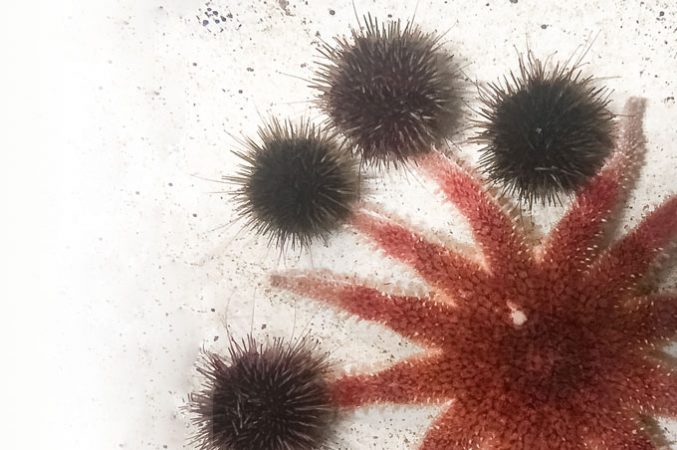Sea urchins are underwater lawnmowers, their unabating, vegetarian appetites capable of altering whole nearshore ecosystems. But the spiny invertebrates will also sink their teeth into something a bit more challenging — and dangerous — new research suggests.
In a first, researchers recently discovered urchins attacking and eating predatory sea stars. The observations flip a classic predator-prey script, researchers report in the June Ethology.
In 2018, marine behavioral ecologist Jeff Clements and his colleagues were at the Kristineberg Marine Research Station in Fiskebäckskil, Sweden, studying common sun stars (Crossaster papposus). At one point, Clements wanted to separate one of the sun stars for a short while and needed aquarium space. He placed the starfish in a tank containing about 80 green sea urchins (Strongylocentrotus droebachiensis).
“I thought, ‘Okay, there’s a bunch of sea urchins in there, these guys are predators of urchins, nothing’s gonna happen,’” recalls Clements, of Fisheries and Oceans Canada in Moncton. The urchins, he says, hadn’t eaten anything in two weeks.
The next day, when Clements came into the lab, he couldn’t find the sun star. There was a pile of urchins on the side of the tank, with something red barely visible underneath. Clements pried the urchins off, revealing the victim.
“The sea star was absolutely decimated,” he says. “The urchins had just ripped it apart.”
Clements and his colleagues soon realized this behavior hadn’t been documented before, So, the team ran two trials, each with a single sun star in the urchin tank, recording how this “predator-prey role reversal” plays out.
One urchin would approach the sun star, feeling around, eventually attaching to one of the sun star’s many arms. Other urchins would follow suit, covering the sun star’s arms. When the team removed the urchins after about an hour, they found the arm tips were chewed off, along with the eyes and other sensory organs positioned there.

This aspect of the sun star’s anatomy may put it at a disadvantage.
“[The tips] are the first part of the sun star that the urchin is going to encounter as it approaches,” says Clements. “So if the urchin consumes those first, the sun star is going to be less effective at escaping the attacks.”
The team has named this incapacitation “urchin pinning.”
It’s possible the urchins are acting in self-defense, preemptively destroying a predator in their midst. Though, it could be the urchins’ relative hunger that’s behind the attacks instead, says Julie Schram, an animal physiologist at the University of Alaska Southeast in Juneau not involved with the research. In crowded lab conditions with limited food — similar to this study — urchins can switch up their diet in surprising ways, she notes. Some species have been documented cannibalizing each other, for instance.
“This would suggest to me that when starved, adult urchins will seek out alternate food sources,” she says.
Urchins’ capacity to feed on predatory sea stars had been hinted at before, with sea stars turning up in urchin stomach contents, says Jason Hodin, a marine biologist at the University of Washington in Friday Harbor. But this was often interpreted as scavenging.
“Active predation was the more interesting possibility, and it’s satisfying to see that possibility confirmed, at least in the lab,” says Hodin, who was not involved with the research.
If these urchin attacks are something that also happens in the wild, Clements thinks there could be some interesting ramifications for kelp forest ecosystems. When overabundant, urchins can graze kelp forests down to nothing (SN: 3/29/21), leaving behind urchin “barrens.” If urchins are feeding on whatever animals are left behind, it’d be easier for their numbers to remain high.
“If [the urchins] are using animals to persist in these urchin barrens when kelp is low or nonexistent, it could actually delay the recovery of these kelp forests back to their original state,” says Clements.
Such discussions of ecosystem influences are premature, says marine ecologist Megan Dethier, and are making way too much out of a “peculiar lab situation.” Such attacks haven’t been documented even in urchin barrens, where food is scarce, notes Dethier, of the University of Washington Friday Harbor Laboratories.
And the urchin attacks can’t be intentional since the animals don’t have a brain or central nervous system, she says. “Urchins doing a coordinated predatory attack is not biologically feasible.”
The synchronized attacks may be based on chemical consequences of the ongoing feeding releasing smells into the water, Clements says. Once the first urchin starts chewing on the sun star, the other urchins may start recognizing the sun star as food. In the future, Clements wants to run experiments manipulating the hunger and density of urchins to see what factors influence their appetite for sun stars.
The findings are a reminder that even with simple nervous systems, invertebrates like urchins can execute surprisingly complex behaviors, Clements says. “These animals aren’t just kicking around doing nothing on the [sea] bottom.”
The Link LonkMay 21, 2021 at 08:00PM
https://ift.tt/3oAEYZE
Urchin mobs team up to butcher sea stars that prey on them - Science News Magazine
https://ift.tt/2CoSmg4
Sea

/cloudfront-us-east-2.images.arcpublishing.com/reuters/CZF6NULMVVMEXHOP7JK5BSPQUM.jpg)
No comments:
Post a Comment